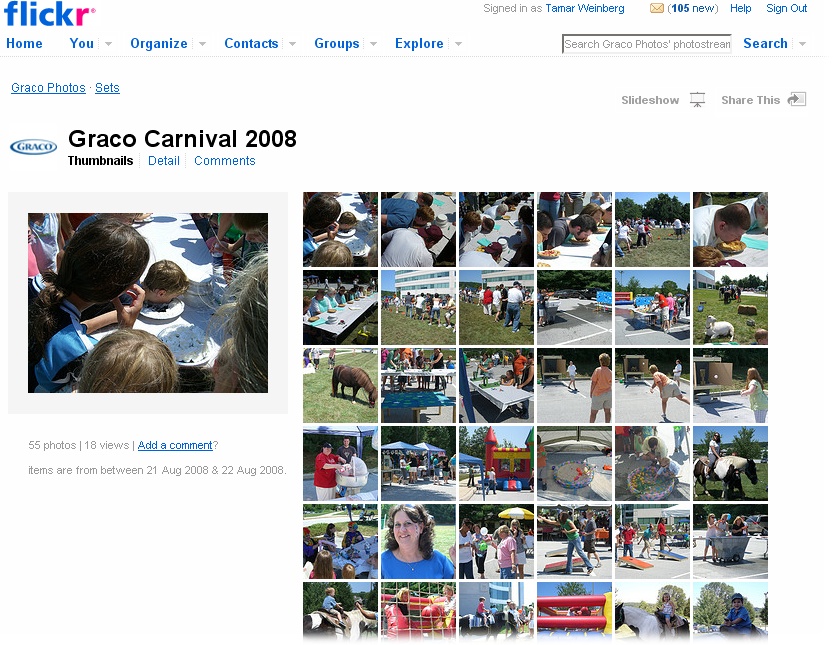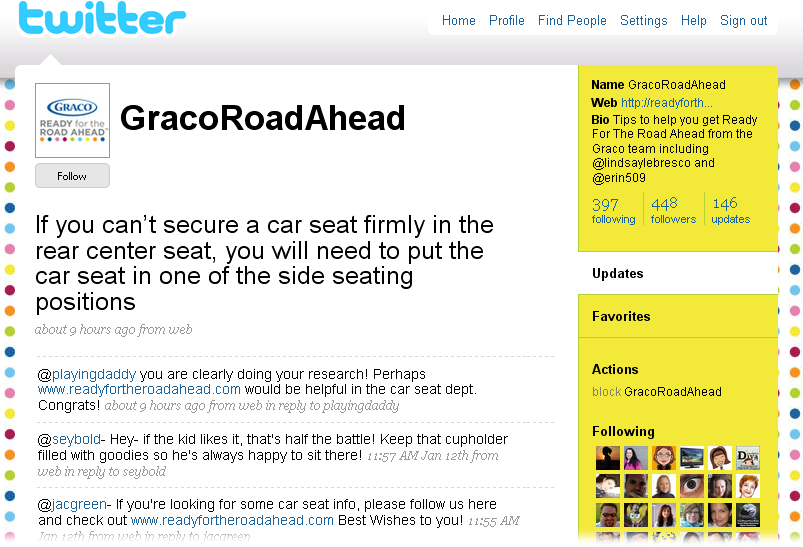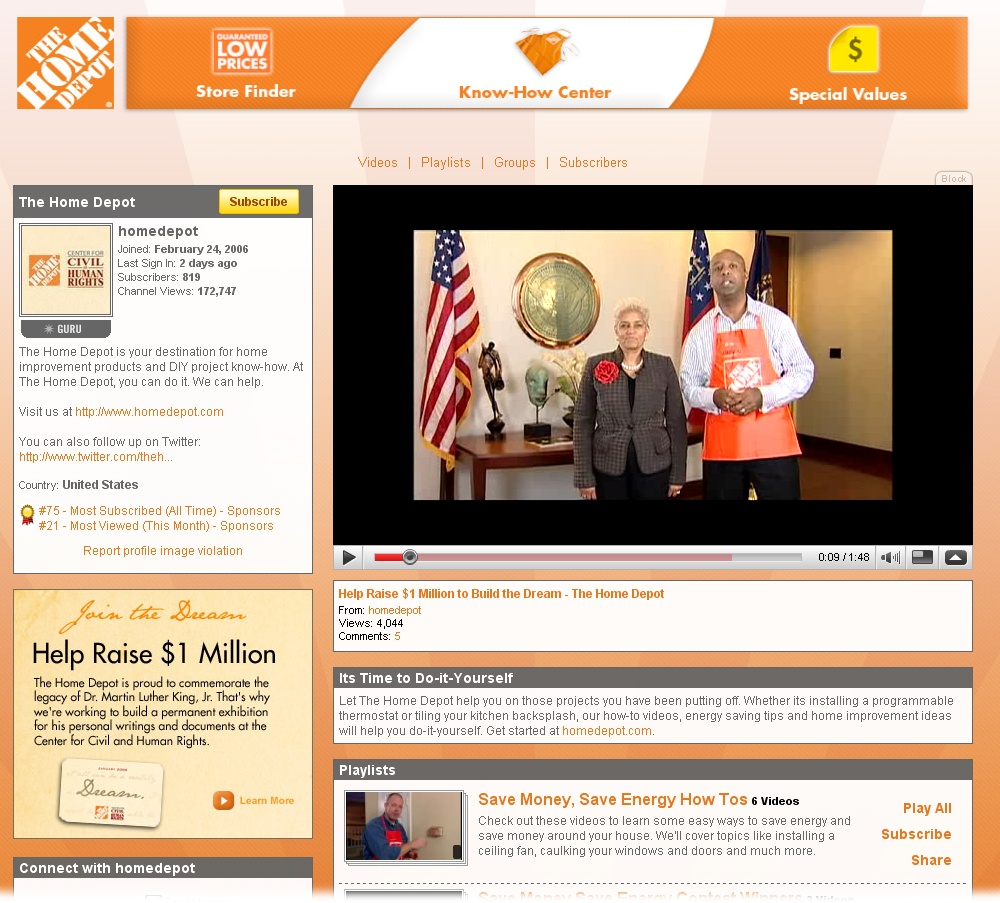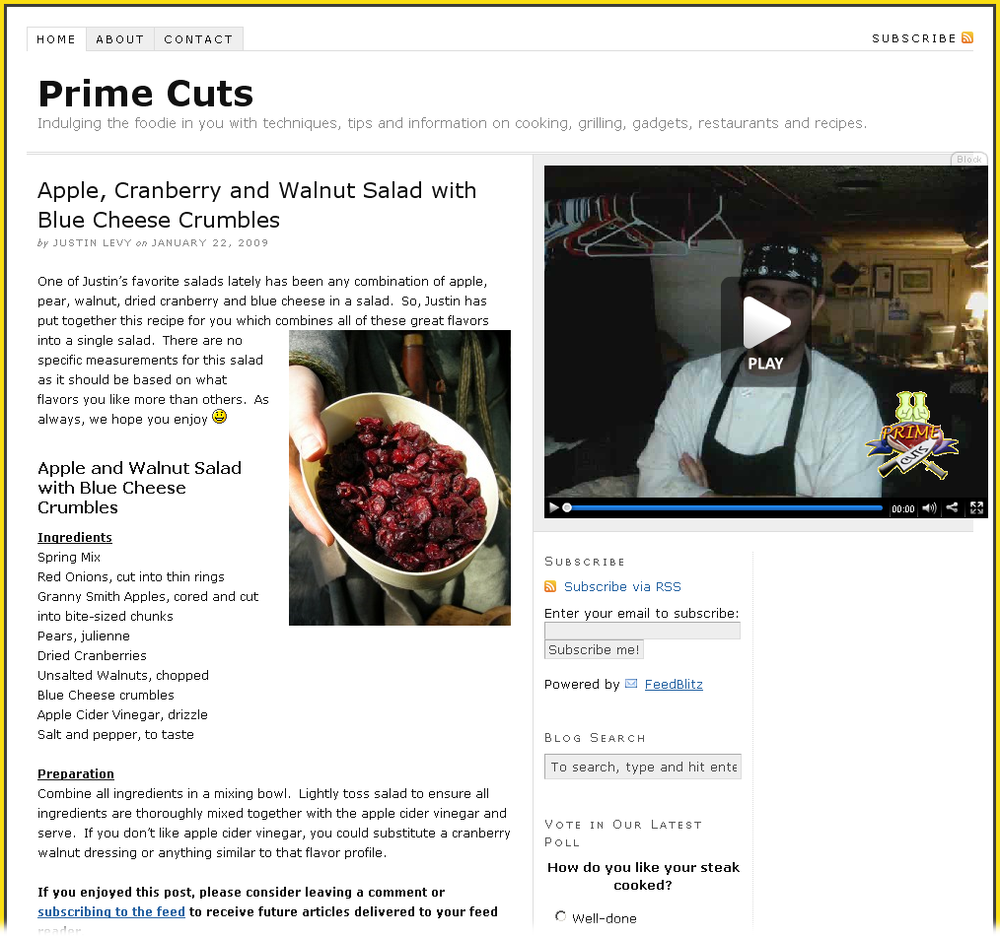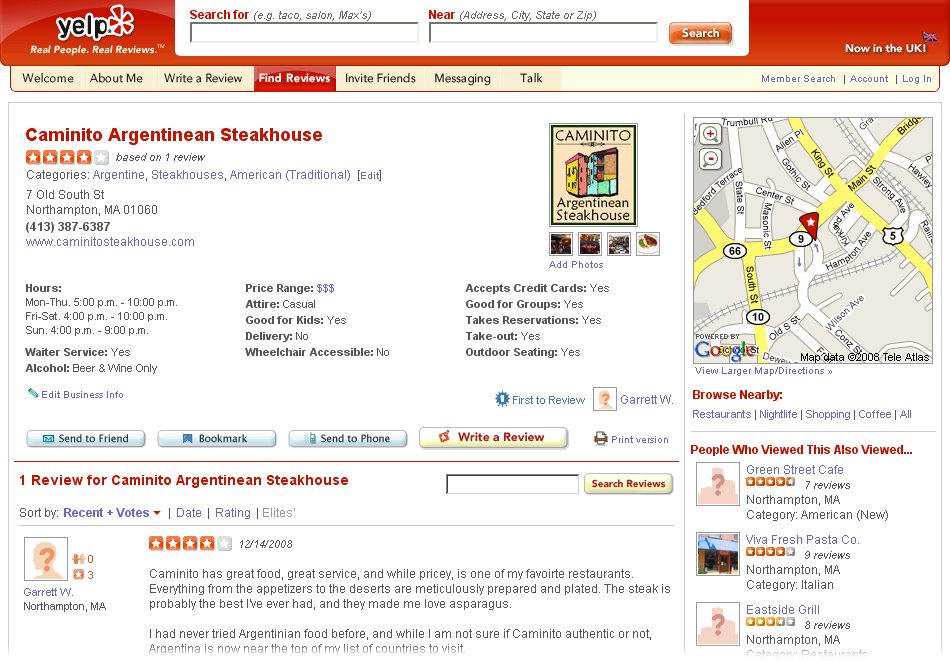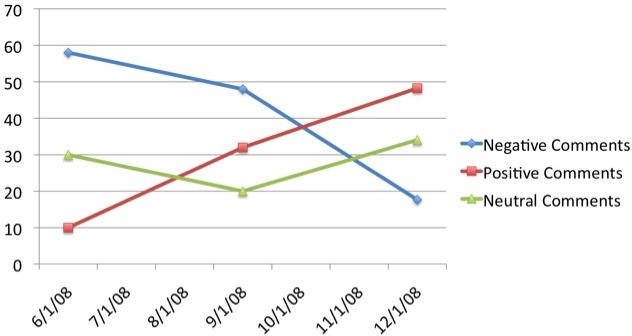Participation is essential for success within social media marketing campaigns. As you’ve learned in the previous chapters, constant engagement is necessary, but real conversations are even more important. The most effective form of social media marketing requires relationship building in a completely authentic way. In this chapter, we review several case studies and show how companies can empower themselves by engaging in social media marketing. We also look at how you can avert or more successfully address reputation management issues via social media marketing channels.
In April 1999, several marketing masterminds released a precursor to the social media marketing of today in The Cluetrain Manifesto (Basic Books), a manuscript of 95 marketing theses. The message of The Cluetrain Manifesto is simple but very powerful: markets converse with one another and the Internet has facilitated this communication. Because the Internet has a profound impact on both consumers and organizations, with improved communication across Internet channels comes the responsibility for organizations to adapt to an evolving environment.
Tip
The 95 theses of The Cluetrain Manifesto are available for free online at www.cluetrain.com. Additionally, a print copy of the book is available at bookstores.
Given that social media marketing as a practice is still an emerging technology, The Cluetrain Manifesto was years ahead of its time. We’re now beyond the 10-year anniversary of its publication and its message is as important as ever. While the authors of The Cluetrain Manifesto were able to accurately predict a marketing revolution, only a small fraction of individuals have actually jumped on the bandwagon. Social media marketing and Internet-facilitated conversations are still not fully mainstream and the importance of Cluetrain’s 1999 message is not necessarily being emphasized. There’s still time, and with 10 years having passed since the document was published, all markets should really understand that this is the prime time to create real, valuable conversations.
If you’re the first person in your industry to engage in social media, by all means, don’t let it hold you back. You can lead by example.
Back in 2007, new media marketer Chris Heuer coined the phrase “participation is marketing.” Heuer asserts that the best marketing minds are those who participate in the communities they service and don’t just aim to sell products directly to the people. After all, companies and organizations exist to help people with a specific problem; the original purpose of these organizations was to participate in order to address a particular need. Moreover, pitching products and services is an outdated tactic that will not be well received among individuals who have either grown tired of the same old marketing message strategies or who have gotten accustomed to the newer tactics of social media engagement.
I’m going to take the phenomenon a step further and argue that the phenomenon of “participation is marketing” also works the other way. While marketing folk may be participating in communities—and that translates to “participation is marketing” (especially as the involvement humanizes the company and is not as self-serving if done appropriately)—I’d argue that community members who are using social media to participate directly with these marketing people are also supporting the claim of “participation is marketing” because they are showing an interest in being part of the greater marketing message. Participation, again, goes both ways. If marketers engage in a community that is not frequented by consumers, they are not serving the greater community and the consumers are not participating in the marketing message. Of course, to realize the idea of “participation is marketing,” the consumer must actually engage in the marketing message, whether by commenting, by vote endorsements, or by referrals, but two-way communication is crucial. In this regard, loyalty is built by fostering genuine relationships with the members of the community. Chris Heuer says:
If you are trying to sell something to the community, and that is your reason for being there, it will be obvious to those people and you will never be as successful as you can be. If you are participating because you really want to contribute to the community, because you really want to share what you know, because you really want to be of service to the community and its members, you will sell to the right people BECAUSE of your sincerity and honesty.
Today, trust is not easily bought with advertising dollars. Not anymore. Establishing relationships is a critical element to the notion that “participation is marketing.” In the previous chapters, we looked at the importance of monitoring the conversation and responding to feedback. The key here is to actually follow communities where your brand, product, and service are mentioned, and to engage altruistically with real interpersonal human interactions. It’s not enough to maintain a blog or to respond by using the Press section of your website to “participate” (this was part of the tremendous misstep in the Motrin Moms campaign that was discussed in Chapter 3). Participation requires ongoing and real dialogue on a consistent basis. If you’re ready to engage (and hopefully by reading this far, you’ve made the decision to participate), you should consider a comprehensive strategy that accommodates users in communities where your products are discussed. You also should be completely genuine at all times. Further, if you immediately spot a perception issue about your brand, don’t immediately push your message onto the community constituents. Walk a mile in their shoes first to understand their mindset and mentality. Later in this chapter, we’ll explore case studies illustrating the “participation is marketing” phenomenon.
The area of public relations is also seeing a tremendous evolution and paradigm shift. Communicating on behalf of a client to a group of constituents via snail mail, phone, or email is obsolete. In keeping with the “participation is marketing” theme, public relations professionals should actually have relationships with the public, which goes beyond the standard press release. Further, online communities are becoming more influential than traditional media outlets. A successful social media campaign can immediately raise product awareness for hundreds of thousands of individuals who are specifically seeking out these communities for relevant news. On the other hand, these same social media consumers are not looking for the traditional pitch. They are looking for newsworthy content that the community as a whole believes is relevant to a wider audience. They rely on the valuable and selfless contributions made by reputable members of these sites and communities.
Public relations professionals will need to up the ante in terms of how they communicate on behalf of their clients. The ideal PR professional is a community participant and not just someone who is solicited to send out an often irrelevant pitch to a publication.
In 2007, social media agency Converseon had the challenge of creating a social media strategy for 66-year-old brand Graco Children’s Products. The challenge: to determine how an old brand could interact with young parents who use the Internet. How could Graco find individuals to target? Most significantly, how could it tap into these communities without appearing overtly commercial?
The first thing that Graco realized was that it needed to research the social media space. In time, Graco discovered that there are numerous parents using message boards and forums, that there are a multitude of Mommy Bloggers, and that these parents are also engaged on other social networks, such as Twitter and YouTube.
To gain awareness, Graco determined that it should establish long-term relationships with active parents engaged in these online communities. Naturally, the goal was for Graco to make its way into these communities authentically. After discovering the online parenting communities, Graco listened to the ongoing conversations within these networks. Doing this helped it devise a strategy that made it an accepted participant in the ongoing conversation and humanized the entire Graco brand. After all, many of Graco’s employees are also parents looking out for the best interests of their children.
By listening (or “conversation mining”), Graco discovered that the parenting communities were resistant to commercial endeavors. Thus, it learned that altruism was important; instead of forcing its brand name into the communities, the company and Converseon ended up using Graco’s name in tandem with real-life events and get-togethers for parents. This specific environment was more accepting of the Graco brand name, and it became a great way to capture the minds of influencers in the parenting space. It was also an appropriate avenue for Graco to engage with the community. After these in-person meetings, a parent-centric blog was launched. Multiple Graco employees currently contribute to the blogging effort.
Graco didn’t stop there. It also engages in Flickr (www.flickr.com/photos/gracobaby; shown in Figure 4-1), Twitter (http://twitter.com/gracobaby; shown in Figure 4-2), and YouTube.
To date, Graco has seen a lot of successes with its social media strategies. After monitoring the conversation, Graco observed that the brand was discussed in a more positive light (up to 83% in 2008 from 68% in 2007). All posts regarding its outreach efforts (100%) have been positive. Graco observed a substantial increase positive reviews and recommendations for online products. Graco’s social media success has landed it an appearance on the Today Show and in several online publications.
Within six months of the Graco Baby blog launch, it was ranked the 59th best parenting blog in the ParentPower Index.[27] In May 2009, the blog was ranked #34. Graco’s blog drove traffic and visitors and, of course, yielded increased conversions. Graco’s blog enabled it to get a better ranking for competitive search phrases in the search engine results, and the blog is now considered a leading authority according to blog ranking service Technorati.[28]
Today, Graco is truly embracing social media. Lindsay Lebresco, Public Relations and Social Media Manager of Graco, says, “We see social media as a new way to create a stronger, deeper and long-term relationship with our consumers. Social media gives our brand access to our consumers and their needs in a unique environment and allows our messages to be delivered in a personal, transparent and immediate way.”[29]
If you associate your brand with something positive, it can result in good feelings toward your company. Tyson Foods took this idea to the next level when it launched its Tyson Foods Hunger Relief blog in late 2007 (http://hungerrelief.tyson.com). Ed Nicholson, Director of Community and Public Relations at Tyson Foods, explains that the company, which has been involved in hunger relief since 2000, recognized that there was a passionate community of people and organizations who work selflessly on hunger initiatives on a national and local level, but that there was no social media space that catered to these individuals. Further, awareness of the widespread nature of hunger is not very high. Nicholson says, “We know people who have cancer and heart disease. We can personally and emotionally engage and relate to illness. With hunger, it’s not so easy. Once people become more aware and engaged in hunger issues, they have more of an emotional attachment to the subject.” The blog was thus launched to raise awareness of hunger among the American population (Figure 4-3).
From the start of the social media initiative, Tyson realized that it needed to be authentically engaged. Its efforts are completely transparent and genuine. In fact, beyond highlighting shocking hunger statistics and sharing tips on hunger strategy, the Tyson Foods Hunger Relief blogs also shares stories of positive hunger outreach attempts throughout the country in a category dedicated to bringing to light the contributions of numerous “Hunger All-Stars” (http://hungerrelief.tyson.com/AllStars). For example, the All-Stars page recently discussed the efforts of 13-year old Jonathan Crider, who raised $20,000 for his local Oklahoma City food bank, and told the story of Ethel Shepherd, now 80, who started a food pantry 25 years ago out of the basement of her church and is continuing her mission today.
The hunger awareness efforts have not ended with the mere launch of a blog. In a blog post published in August 2008, Tyson Foods invited the community to participate in a food donation of epic proportions. For every comment left on the blog post, the company promised to donate 100 pounds of food to a food bank in Austin, Texas. Within six hours, an entire truck had been filled. There are more than 650 comments on the blog post to date.
In December, Tyson launched a more powerful hunger giveaway to the Greater Boston Food Bank. Once announced, it took less than two hours for the first truck to be filled to the brim with food. A second truck was also filled by the end of the day. There are over 900 comments on the blog post.
Beyond the blog, Tyson is also actively involved in social media. It uses Twitter to communicate its philanthropic efforts (http://twitter.com/tysonfoods, shown in Figure 4-4). It also shares its outreach attempts via Flickr (g). Nicholson maintains LinkedIn and Facebook accounts that he acknowledges are integrated with his activity at Tyson Foods. All of these specific social media accounts have contributed to awareness of the Tyson Foods brand.
Tyson continues to update its blog with posts about its charitable contributions. But Tyson also finds that its positive engagement has amounted to success for the Tyson brand itself. The company has seen increased engagement among the community and improved relationships.
Tyson’s outreach efforts are still new, yet Nicholson notes that Tyson will continue to grow the communities to become a leader in this area. Nicholson adds, “We don’t give the most money but we have this product we can give.” Tyson Foods will continue to leverage the communities it has, to be a part of the community, and to become an important player in the social media space.
Due to its initial fear of the uncontrolled message, The Home Depot took a logical approach toward social media with several slowly evolving initiatives. Based on the success of these programs, the company delved deeper into the social media space. In the end, these initiatives, beginning with product reviews and expanding to social media channels, including YouTube and Twitter, have resulted in a lot of success for the retailer.
Nick Ayres, an Interactive Marketing Manager at The Home Depot, has been at the company for over three years and has been instrumental in helping it seek out several different social media outreach campaigns, which have all shown varying levels of success.
The first step toward social media involvement and awareness for The Home Depot was encouraging the community to write reviews on products marketed and sold by the company. Using this tactic, The Home Depot initially saw how customers involve themselves in the social space. As Ayres notes, The Home Depot was initially fearful of the unknown, especially the negative, so offering product reviews was a preliminary baby step into the world of social media. He says, “If we opened the floodgates of letting customers tell us about the Home Depot brand, we were afraid to see a lot more negative than positive. It’s a lot less of a concern when you start with product reviews as that’s a logical extension of what we’ve been doing.” With product reviews, users have the ability to evaluate their purchases in the same way others do on a big front-facing site like Amazon.com.
Response to product reviews has been overwhelmingly positive, he says. “This is one of the few areas where we can tactically say that there’s a good financial upswing for us that you can really see in the general marketplace. Generally speaking, products that have higher ratings and reviews do better from a sales perspective.”
The Home Depot’s next social media venture was in leveraging video sites to teach users how to do things in the house. The Home Depot has an official YouTube channel that showcases video demonstrations of do-it-yourself home projects (www.youtube.com/user/HomeDepot; shown in Figure 4-5). The video library is relatively robust, with over 80 videos and hundreds of subscribers. Video topics range from home improvement to energy efficiency. As for why YouTube and other video sites were preferred channels for The Home Depot, Ayres notes that the content has always been at customers’ disposal, but, “We wanted to engage with a different audience in a much more real-time and personal way.”
Additionally, The Home Depot uses Twitter (http://twitter.com/thehomedepot) to broadcast company updates and communicate with users, particularly for customer service issues. In the summer of 2008, Twitter was abuzz with news on Hurricane Gustav. The Home Depot capitalized on the opportunity to communicate accurate store information as it related to hurricane preparation. For instance, the company’s Twitter account was used to communicate store closings and offer information on the availability of essential supplies in local stores. The Twitter stream was not directly used to sell products, but rather to articulate information and availability to those needing timely updates. Plus, for the retailer, the information was already readily available, as The Home Depot had a well-defined hurricane process at its hurricane headquarters. The hurricane information was available to in-store customers and online on The Home Depot’s website, but was later disseminated in bite-size chunks and passed along to the general public using Twitter.
Ayres finds that The Home Depot is successful because it’s using already available information to arm the public with knowledge: “Our biggest wins to date have been not trying to reinvent the wheel, but by taking what we knew worked and trying to find the places where that information and products made the most sense in the social media/Web 2.0 world. We’ve seen pretty positive reactions because of the way we went about our social media initiatives strategically from the start. We are always taking feedback and our successes to invest in the future.”
In the future, The Home Depot is going to extend its “digital orange apron” (its signature in-store “uniform” is the orange apron) to provide consistent customer experience across all media channels and to serve this information up to a whole generation of customers. Armed with “digital orange aprons,” the company will be able to take the resident knowledge of employees and associates and present it in a way that will be more accessible to customers engaging in the social media space.
Ayres himself is involved in social media; he mentions that he maintains his own Twitter account, but that The Home Depot has an official channel that is managed by its Corporate Communications team. He acknowledges that before The Home Depot made its debut on Twitter, the retailer asked the community how the microblogging service should be used, because it was not sure whether to use the Twitter account to offer sales messages or for customer service. The community responded that it would prefer the account to be focused on addressing customer concerns, and The Home Depot listened. Therefore, Ayres may use his own personal Twitter account to circulate The Home Depot messages from time to time. However, he notes that while he will sometimes reach out to customers to assist them with issues, he will always do so in a transparent way. It is important for The Home Depot and other companies to have representatives who are able to speak on the company’s behalf, while also making it clear that they may be offering their own personal opinions.
In the aforementioned three case studies, large companies took the initiative in social media efforts. But social media is still a viable advertising method for small businesses. Indeed, “participation is marketing” can work for the smallest to largest companies. Here’s how a brick-and-mortar business with one single presence—a restaurant location in Northampton, Massachusetts—was able to succeed in social media.
One of the partners at Caminito is an Internet Marketing professional by day, with a thorough understanding of the social media space. Justin Levy has used social media effectively in lieu of more traditional forms of advertising, such as newspaper advertisements, travel guide listings, and a prominent feature in the local Yellow Pages.
Levy has used his knowledge to bring Caminito fully into a social media space. The official steakhouse web page (www.caminitosteakhouse.com) is updated regularly, but beyond that, it has launched the Prime Cuts Blog (http://primecutsblog.com), on which Caminito shares cooking tips on with recipes, gadget reviews, and videos (Figure 4-6). Caminito also has an exclusive YouTube channel (www.youtube.com/user/primecutstv), known as “Prime Cuts TV,” on which it offers additional “see it yourself” instructional videos. For example, it recently uploaded videos entitled “How to Sharpen Your Knife Using a Wet Stone” and “How to Fabricate a Whole Ribeye.” Further, using video-sharing service Viddler (www.viddler.com/explore/primecutstv), these videos are published in higher quality on the Prime Cuts Blog.
Caminito has also realized the importance of social media in a long-term “how do people find us?” search engine optimization strategy. Being omnipresent means that people can discover Caminito using a variety of online search phrases. To achieve these results, the restaurant actively encourages patrons on its web page to review the restaurant on business review site Yelp (www.yelp.com/biz/caminito-argentinean-steakhouse-northampton; shown in Figure 4-7). It also has tapped into the local youth crowd by creating a MySpace profile page (www.myspace.com/lasbrasasnoho), where it posts events and points visitors to the official Prime Cuts Blog.
Justin Levy remains affiliated with Caminito through his personal social media accounts as well (as listed on the Prime Cuts Blog sidebar). He’s active on social geo-aware network Brightkite, shares his social media– and food-related bookmarks on delicious, lets people monitor his blog comments through comment-monitoring tool Disqus, highlights his social media accomplishments and personal achievements on his Flickr photostream, aggregates his social media stream on FriendFeed, networks with professionals via LinkedIn, bookmarks websites via social-discovery tool StumbleUpon, regularly interacts with users via Twitter, and broadcasts his upcoming schedule of events at Upcoming.org. Clearly, Justin has shown that there is no shortage of options for the types of interactions he can have with community members.
Of course, Caminito also actively monitors the conversation using Google Alerts. Caminito uses this information to learn more about what people are saying about it and also for competitive analysis to understand what other Argentinean steakhouses are doing in other locations. Using this data, Levy is able to keep abreast of menu changes, new ideas, good and bad reviews, and other tactics Caminito can then use for its long-term growth.
To measure success, Caminito monitors web analytics regularly. Based on the data provided, it enhances its social media engagement across several networks or makes necessary adjustments.
In the end, Caminito is seeing much success with its social media marketing initiatives. Its search engine rankings are phenomenally high, which is incredibly important in its market. Its web page often shows up multiple times for a specific search, which ends up bolstering the brand itself and reinforces Caminito Argentinean Steakhouse as the ideal restaurant for the particular query performed. In an interview with Social Media Explorer,[30] Justin says, “We have seen an approximate 30% boost in sales (year to date) in a time where a lot of restaurants are down 10–20%. Not all of that can be attributed to our online presence but I’m sure a good portion of it can.”
He’s probably quite right.
You may have spent decades building the empire that now houses your brands and hundreds of thousands of employees. But reputations are precarious; within a matter of moments, your hard work can come tumbling down when a customer (or even a competitor) uses the Internet to tarnish the good name that you have been trying so hard to maintain. Given the proliferation of content on the Internet, one bad story can easily spread like wildfire. Companies that do not react to the firestorm can suffer considerable loss of trust and may even lose brand share.
Social media is a cost-effective and beneficial way to combat these kinds of reputation management fiascos. There are several ways to address reputation management using social media. In Chapter 2, you learned how Electronic Arts transformed what could have been a demerit among its fans into a superb marketing piece that in itself was incredibly viral. As you may recall, a user discovered a software glitch illustrating a humanly impossible feat, and uploaded a video showing this phenomenon to YouTube. EA Sports opted not to ignore this video and responded by making a genuinely realistic illustration of how the software bug was not actually a software glitch after all. With over 2 million views and overwhelmingly positive reactions to the video, EA Sports clearly emerged victorious from what could have been a public relations nightmare.
In the Caminito Argentinean Steakhouse case study, I alluded to a second opportunity for social media to assist in online reputation management. In that instance, you learned that the presence of multiple profiles has made Caminito (and Justin Levy) more findable. Caminito maintains several social media profiles across a multitude of social networks, and a search for Caminito using a typical search engine often pulls up more than just the restaurant home page: the results show Caminito’s social media profiles, too. Justin Levy’s personal social media profiles are also widespread across the Internet. If you searched for “Justin Levy” today, you’d likely see his social media profiles scattered throughout the first page of the search results. There are probably hundreds of individuals named Justin Levy out there, but it becomes pretty evident relatively quickly that the Justin Levy on the first page of the search results is the man responsible for the success of Caminito Argentinean Steakhouse.
This example illustrates the power of social media marketing for reputation management. A business that may be hurting in the search engine results can easily set up a number of social media profiles across hundreds of social networks. With regular engagement, social media profiles may help influence the search engine results. This strategy works well because most social networks are trusted by nature of their heavy use (and because they are often linked to by other websites and news outlets). Subsequently, internal pages are often trusted because they are associated with the particular social site’s domain.
The screenshot of the 2008 Comcast search results (in Chapter 1) shows that user-generated content ranks well in search results. Further, ever since Google introduced “universal search” results, it is evident that social media can even make its way into the more visible links on the search engine results page. A search for “sledgehammer” shows one dedicated YouTube result at the top of the page (and in the center of the page, product listings for the item). A search for “Barack Obama” shows regular results scattered with news results, book results, and most significantly, blog posts.
Definition
What is universal search? In 2007, Google decided that the search results were lacking with just 10 plain blue links. Google decided to integrate video, images, blog posts, business data and maps, products, and news results into the search engine results pages. Universal search increases visibility of other possible properties that Google is currently highlighting in its results.
Clearly, social media results are noticeable in nearly every online search. For reputation management, then, social media works very well to combat negative search. Since the majority of social networks allow you to choose your own username, you can claim ownership of the available usernames for your brand or company. Once these social media profiles are ranked within the search results, they can help bolster your online reputation. Use a site like http://knowem.com to see which websites you should register your brand name with so that you can then start to claim your reputation on the Internet. You don’t have to claim every single social media profile, but you should be visible. Once these social media profiles are registered, be sure to use these social media accounts on a somewhat regular basis (at the minimum) to help create value within your communities. This in turn helps you get higher rankings and prevents others from ruining your good reputation. You will not achieve a high ranking just by virtue of creating the social media profiles; engagement is still necessary. Your social media profile page should show that account activity is being recorded. This is helpful because search engines will crawl (or “spider”) more often on pages that are updated more frequently. Thus, the more content you can add to the social media profiles, the more likely it is search engines will notice you. As an added benefit, if you’re recognized as a good contributor by members of the communities that you participate in, your social media profile page may naturally be linked by actively engaged social media participants who may also be bloggers or journalists (my Twitter profile page currently outranks my personal blog for numerous search queries).
Definition
What is a spider? A spider or web crawler is a scripted program that automatically traverses through the Web and gathers data about websites and web pages. Have you ever wondered how Google, Yahoo!, or your favorite search engine actually knows what text is on a website? Each search engine uses a spider to record all text on a web page. On a traditional website, spidering may not happen as rapidly, because search engines do not know about spiders’ existence, but since blog content contacts search engine ping services directly, spiders often come a lot more quickly.
Several months ago, technology company and domain name registrar Network Solutions was under fire for apparently violating ethical considerations by registering domain names that individuals would seek out for availability. In plain English, users performing simple research on domain name purchases via Network Solutions would not be able to register that domain using another registrar because Network Solutions would immediately claim ownership.
With this questionable practice (which one blogger called “extortion”[31]), Network Solutions had a reputation issue that it needed to address quickly to fall back into the good graces of its customers and prospects. Trust was lost and morale was very low.
After hiring public relations firm Livingston Communications, Network Solutions worked with Chief Community and Social Media Evangelist Shashi Bellamkonda on a viable strategy that would help the company to win back the favor of the Internet-savvy audience. Its strategy required three important steps:
Listening, first to monitor online chatter and then to respond on the official Network Solutions blog, Solutions Are Power (http://blog.networksolutions.com).
Adding value to the community (Network Solutions used its blog to convey thoughts and offer industry-related correspondence).
Community participation (communicating in social channels around the Internet on behalf of Network Solutions, leaving the Network Solutions name visible in exchanges).
One of the key contributions to the Network Solutions strategy was the launch of the Solution Stars Video Conference (http://solutionsstarsvideo.com), a website featuring a series of videos that discuss how small businesses can benefit from new media tools. Network Solutions interviewed many experts who had extensive involvement in social media on numerous topics, such as how to build a web presence, whether you should start a blog, how to achieve visibility through search, and how social media provides an opportunity to bypass traditional media channels to directly reach stakeholders. This was a perfect opportunity for Network Solutions, because the video conferences provided great value to the community at large (especially a highly vocal community who wanted to share related content), and many experts who were featured talked about it on their blogs.
Over time, the interactions and the video conferences paid off. Over a six-month period, negative comments about Network Solutions decreased and positive sentiment increased (Figure 4-8).
As far as the issue that contributed to the negative emotions about Network Solutions in the first place, Shashi Bellamkonda says that the practice is no longer being employed.
Today, Bellamkonda contends that social media is a viable two-way strategy that can help all sorts of businesses from the one-man firm to the large corporation. Regardless of company size, social media can facilitate and cultivate strong interpersonal connections. Bellamkonda adds that behind a company’s social media identity, one must be genuine and not just regurgitate the same old corporate communication you would see on a traditional media channel.
It’s important for Network Solutions to actively monitor the social media space for conversation about the company, but also to respond very quickly, as expectations in the social media space have changed, especially with the rise of tools such as Twitter, where customer service is almost immediate (see Chapter 6 for more information on Twitter). With this type of engagement, Bellamkonda acknowledges that, “people are wowed at the fact that they are getting an immediate response.” Bellamkonda says that because Network Solutions is reaching out to customers on blogs, social channels, and Twitter, people are responding more positively toward the Network Solutions brand and are looking at the company in a much better light.
It’s obvious that you must monitor your reputation online, but what exactly should you be looking for? What other reputations should you watch out for? According to online reputation management expert Andy Beal,[32] your company needs to track the 12 reputations that follow.
Naturally, the course of action for any reputation management missteps will vary based on the circumstances, but by actively observing these reputations, you may be able to prevent issues that could be very damaging. In other instances, the information you discover via monitoring can be very rewarding.
- Your name
It doesn’t matter if you’re a big player in the space or a small one; you should always be aware of what people are saying about you in the media. Plus, you can always link to the positive media mentions on your website to let your visitors observe your accomplishments.
- Your company name
Of course, you know this is a given if you’re even considering reputation management at all. Listening to what people are saying about you and your company is crucial. Also, consider legacy company names or well-known abbreviations of your company name.
- Your brand names
If you’re part of a huge company that maintains hundreds of brand names, this may be quite difficult to monitor, but you should follow the more important brands for your business survival.
- Your company’s executives
Always be aware of what people are saying about your company leadership.
- Your company’s media spokespeople
Anyone who speaks publicly on behalf of the company should also be monitored.
- Your slogan or marketing message
What are people saying about your slogan? Is it being well received? On the other hand, is it being infringed upon?
- The competition
What are people saying about your competition? Can you use that information to better your company? Remember, Justin Levy at Caminito Argentinean Steakhouse monitors his local competition to get ideas for his menu and to hear what other people say about other restaurants in the area. Reputation management can still assist with competitive research and analysis.
- Your industry
Most specifically, you should observe industry trends and use this information for your own benefit. Perhaps executives are upset that the highly anticipated desk they just bought has a design flaw and a wobbly drawer. Perhaps the mobile PDA many businesspeople received last week has issues with reading external memory modules. Can you learn from this feedback and correct these mistakes to make a better product? Can you use these learning experiences to your advantage? You can also monitor your industry to see new innovations as they’re announced. Getting this information early is a great way to stay ahead of the curve.
- Your weaknesses
Face it—your product isn’t perfect and there’s always room for improvement. If you’ve read the first three chapters, you know that people are talking about you and they’ll point out flaws with your brand or products. You can use this feedback to grow.
- Your business partners
Do you actively work with a company that is in the news? Perhaps it’s for a good thing; perhaps not so much. Would Ponzi scheme scammer Bernard Madoff’s investors have been better off if they actively monitored his reputation? Perhaps not, but if you have business partners doing better or worse in the business, you probably want to find out about it. If Google’s Q2 earnings do not meet expectations and you are engaging in one of Google’s paid advertising programs, you’d probably want to know that it is having a rough fiscal quarter.
- Your clients
Hear something great about your clients in the news? Andy Beal postulates that if you directly approach them and wish them congratulations and much success, your retention rate will go up.
- Your intellectual property
Any trademarks or copyrights should be actively monitored for infringement abuse or mistaken identity.
You may have been the victim of a reputation management disaster. Now, everyone’s eyes are on you. It will be your responsibility to pull yourself out of it, perhaps by communicating directly with the public at large or by addressing the issue silently via social media content promotion.
Bear in mind that you should always take the high ground and handle reputation crises professionally. Remember, you’re already being perceived in a negative light and you can worsen public opinion by intensifying the situation with haphazard emotion and poor logic.
When you do approach the community, be honest about the apparent crime you have already committed, then take the next step to explain how you intend to rectify the issue (or inform the populace that you have already taken steps to fix the problem). You should also be available to handle specific complaints personally or you may wish to offer communication channels (that you will have a senior staff member answer quickly) to ease the concerns of your constituents. If the community believes that the discussion will not end simply with a public apology, be sure to give it a place where it can continue the conversation offline.
Internally, though, you can avert the reputation management mess (for the future) by learning from these experiences. If you have not yet encountered a publicity disaster, it may be a good time to communicate to your staff about the importance of public perception and reiterate that it should tread carefully and offer the best service because consumers nowadays have easy ways of exposing their dissatisfaction with your support or service offerings. Of course, you can always read about the reputation management disasters of your company and use those experiences to learn what not to do in your industry as well.
The Cluetrain Manifesto alluded to the phenomenon that is social media marketing today. Businesses are talking to one another. Markets are conversations and social media empowers consumers to speak directly to its favorite brands.
Participation is marketing. As marketers, we should take an active role in social media channels and engage in dialogue in a very genuine way. Graco Baby, Tyson Foods, The Home Depot, and Caminito Argentinean Steakhouse are four businesses that have been able to illustrate the “participation is marketing” trend with very positive returns for their business.
Social media marketing can also aid in reputation management tactics. There are two ways this can be done. When a company is involved in the conversation, the company itself can help nurture and shape impressions of the public, usually for the better. Network Solutions showed that listening turned negative sentiment into a positive one.
The second way social media can help facilitate reputation management is via social media profile building. Companies can create user accounts named after the brands they need to monitor via social media channels and then use these profiles to boost search engine results. Continuous and meaningful engagement is necessary so that search engine spiders can discover the profile pages, see that there is frequent activity, and ultimately, often by trust, rank these profile pages higher in the search results.
There are 12 reputations that you should monitor consistently so that you can keep abreast of developments and perceptions about your company, your industry, and your competitors. When you’re armed with this information, you should be able to easily address most, if not all, reputation management issues.
Get The New Community Rules now with the O’Reilly learning platform.
O’Reilly members experience books, live events, courses curated by job role, and more from O’Reilly and nearly 200 top publishers.
